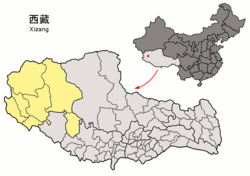The paved Xinjiang-Tibet Highway (新藏公路) passes through this area. There are well-known prehistoric petroglyphs near the far western town of Rutog.
The town of Ngari lies 4,500 metres (14,800 ft) above sea level in northwest Tibet some 1,600 kilometres (990 mi) west of the capital, Lhasa. Ali Kunsha Airport began operations on July 1, 2010, becoming the fourth civil airport in Tibet (shortening the trip to Lhasa to one-and-a-half hours from three or four days by car) along with Lhasa Gonggar Airport in Lhasa, Qamdo Bamda Airport in Chamdo and Nyingchi Mainling Airport.[2]
Ngari is best known for Mount Kailash, also called Sumeru, and Lake Manasarovar. Mount Kailash is 6,714 m (22,028 ft) above sea level and is the main peak of the Transhimalaya (also called the Kailash Range or Gangdisê Mountains). The holy mountain and lake are associated with number of religions: Buddhism, Hinduism, and Bon, among others, attracting numerous domestic and international religious pilgrims and tourists. Surrounding Mount Kailash are four ancient and famous monasteries: Zhabura, Chiu Gompa, Zheri and Zhozhub. Manasarovar lies 4,588 m (15,052 ft) above sea level, covers an area of 412 km2 (159 sq mi) and reaches a maximum depth of 70 m (230 ft).
Ngari has a cold desert climate (Köppen climate classification: BWk), with strong dry-winter subarctic climate tendencies (Köppen climate classification: Dwc).
More information Climate data for Shiquanhe (1991–2020 normals), Month ...
| Climate data for Shiquanhe (1991–2020 normals) |
| Month |
Jan |
Feb |
Mar |
Apr |
May |
Jun |
Jul |
Aug |
Sep |
Oct |
Nov |
Dec |
Year |
| Record high °C (°F) |
6.4
(43.5) |
9.5
(49.1) |
14.5
(58.1) |
15.7
(60.3) |
20.5
(68.9) |
25.2
(77.4) |
32.1
(89.8) |
26.4
(79.5) |
23.7
(74.7) |
16.7
(62.1) |
12.7
(54.9) |
7.1
(44.8) |
32.1
(89.8) |
| Mean daily maximum °C (°F) |
−4.0
(24.8) |
−1.8
(28.8) |
2.7
(36.9) |
8.1
(46.6) |
13.0
(55.4) |
18.5
(65.3) |
22.0
(71.6) |
20.8
(69.4) |
16.8
(62.2) |
8.8
(47.8) |
3.6
(38.5) |
−0.6
(30.9) |
9.0
(48.2) |
| Daily mean °C (°F) |
−11.7
(10.9) |
−9.0
(15.8) |
−4.4
(24.1) |
0.9
(33.6) |
5.7
(42.3) |
11.3
(52.3) |
15.0
(59.0) |
14.2
(57.6) |
9.9
(49.8) |
1.3
(34.3) |
−4.7
(23.5) |
−9.0
(15.8) |
1.6
(34.9) |
| Mean daily minimum °C (°F) |
−19.3
(−2.7) |
−16.6
(2.1) |
−12.3
(9.9) |
−7.0
(19.4) |
−2.0
(28.4) |
4.1
(39.4) |
8.5
(47.3) |
8.1
(46.6) |
2.8
(37.0) |
−7.0
(19.4) |
−13.0
(8.6) |
−17.1
(1.2) |
−5.9
(21.4) |
| Record low °C (°F) |
−36.6
(−33.9) |
−30.2
(−22.4) |
−25.3
(−13.5) |
−17.9
(−0.2) |
−11.2
(11.8) |
−6.6
(20.1) |
−0.6
(30.9) |
−0.4
(31.3) |
−10.0
(14.0) |
−17.0
(1.4) |
−23.5
(−10.3) |
−32.9
(−27.2) |
−36.6
(−33.9) |
| Average precipitation mm (inches) |
1.6
(0.06) |
1.7
(0.07) |
1.1
(0.04) |
1.3
(0.05) |
2.9
(0.11) |
5.8
(0.23) |
22.9
(0.90) |
25.3
(1.00) |
5.5
(0.22) |
1.7
(0.07) |
0.2
(0.01) |
0.6
(0.02) |
70.6
(2.78) |
| Average precipitation days (≥ 0.1 mm) |
1.8 |
2.0 |
1.3 |
0.9 |
2.0 |
2.8 |
7.0 |
8.7 |
3.1 |
0.7 |
0.4 |
0.6 |
31.3 |
| Average snowy days |
3.9 |
4.3 |
3.6 |
3.5 |
4.8 |
2.1 |
0.1 |
0.3 |
1.0 |
1.4 |
1.0 |
1.6 |
27.6 |
| Average relative humidity (%) |
34 |
33 |
29 |
27 |
28 |
30 |
37 |
42 |
34 |
24 |
24 |
26 |
31 |
| Mean monthly sunshine hours |
250.1 |
241.3 |
299.1 |
304.9 |
332.8 |
333.6 |
309.9 |
289.9 |
299.7 |
311.1 |
274.7 |
262.6 |
3,509.7 |
| Percent possible sunshine |
78 |
77 |
80 |
78 |
77 |
78 |
72 |
71 |
82 |
90 |
88 |
85 |
80 |
| Source: China Meteorological Administration[3][4][5] |
Close

